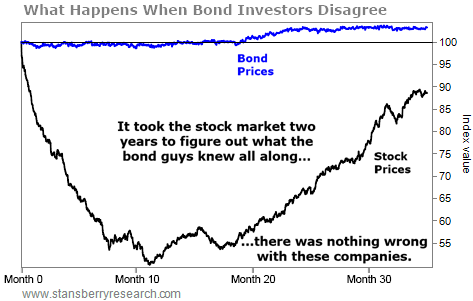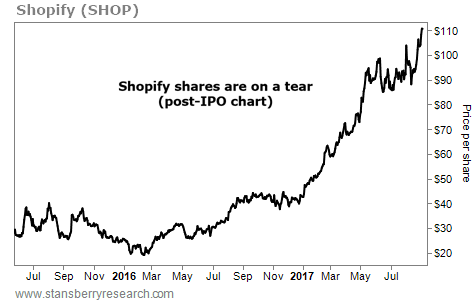| Home | About Us | Resources | Archive | Free Reports | Market Window |
What the 'Smart Money' Knows... And the Stock Market Doesn'tBy
Wednesday, September 6, 2017
We finally have conclusive proof of something we've always believed...
The bond market is smarter than the stock market.
You may have heard this saying before... It's one of Wall Street's oldest adages. And it's one of our core beliefs from nearly 20 years of studying the markets at Stansberry Research.
But until recently, it had just been a "gut feeling" that we had... We could never find concrete evidence. It was frustrating, so we decided to conduct our own study.
Today, we're going to share a critical detail about our findings with you... You see, while we knew this belief was true, the results were so dramatic that even we were surprised.
And they revealed an incredible indicator for finding stocks that could double your money...
As longtime subscribers know, our bond team combs through roughly 40,000 bonds each month and only identifies a handful of true "outliers" that are worthy of further research. Generally, the equity markets contain many more outliers – both long and short opportunities.
Over the years, we've come to agree with Benjamin Graham – "the father of value investing" – that eventually the stock market gets valuation right. But it can take years to happen.
It certainly makes sense. After all, the stock market is littered with unsophisticated individual investors and day traders who are hoping to make a quick buck.
The bond market, on the other hand, is different...
The U.S. bond market is about 50% larger than the stock market. There's more than $39 trillion invested in bonds in the country. And unlike the stock market, almost all the trading is done by the so-called "smart money."
Simply put, the bond market attracts a different kind of investor. Mainly, the bond market is filled with institutions like banks, insurance companies, and pension funds – stodgy old organizations that have no emotional attachment to their capital.
The members of this "financial elite" are widely regarded as being better at seeing broad market moves much sooner than their counterparts in the equity markets. That's where the old saying comes from. And that's why even the most experienced stock traders often look to the bond market for signals of what's to come in the equity market.
Equity investors are often jittery and shortsighted. They'll throw in the towel and sell a stock when the company has one bad quarter. Some even give up when the company has a good quarter – if it isn't as good as they had hoped.
Bond traders look past all of this short-term noise. They seek to understand true fundamental changes in the long-term prospects of each company. They don't bail out just because a company missed Wall Street's latest quarterly expectations.
A few months back, our bond team became fascinated with a scenario that plays out dozens of times every year. What happens when the stock market and bond market disagree about a company?
Sometimes, the price of a stock sells off sharply, but the company's bonds maintain their value. In other words, equity investors lose faith in the stock, while bond investors remain confident in the company's future.
But we wondered... does this divergence tell us anything?
To answer this question, our team compiled what we believe to be the world's most extensive analysis done on what happens when the bond and stock markets disagree.
Our team studied more than 1,000 situations when a stock fell more than 50% over a short term. (That's a huge selloff, and it signals that stock investors gave up on the company.) For companies that had bonds outstanding during that time, we looked at how their bonds performed over the same period.
In hundreds of those scenarios, the bond market "disagreed" with the stock investors. And just as we expected... our findings proved that bond traders are much better at predicting the long-term prospects of a company. Take a look...
 The black line is a representative index of various "bond market disagreed" situations that occurred in stocks from 2010-2014. The horizontal axis represents the number of months from when the stock market first began to sell off these stocks. Now, you would expect bonds to fall less than stocks. Bonds are better securities to hold in times of trouble. Remember, bondholders have a more senior claim on a company's assets than the shareholders have. Bondholders have historically recovered around 40% of their investment in bankruptcy proceedings, while equity investors usually get nothing.
But when the price of a company's stock is slashed in half and the bonds only drop by a single-digit percentage, that's a flat-out disagreement between bond and stock investors' expectations.
This clearly shows the bond market gets it right much earlier than the stock market. When a company's stock falls but its bonds don't... the stock market almost always ends up "agreeing" with the bond market, and shares bounce back toward their prior levels.
But here's what shocked us...
As the chart demonstrates, investors who bought shares when the market had given up on them routinely doubled their money (or better)...
You can think of it like this. On average, the stocks in this "bond market disagreed" population were trading at $100 a share and dropped to $40 a share. (That's a 60% loss.) Within two years, this "average" stock was trading for $89 a share. That's 11% below the pre-fall levels... But it's more than a double from the low. ($89 is 123% higher than $40.)
In other words, the bond market knew what the stock market didn't... These companies were fine. And if you had bought the stock of these companies after the initial drawdown, you would have more than doubled your investment in less than two years!
Our bond team had stumbled upon the greatest "bounce-back predictor" we'd ever seen.
Mathematically, these stocks double just by getting back to the levels where they previously traded. These companies don't need to soar to new heights... They just need to get back to where they were.
So whenever you see a huge divergence in the behavior of a company's stock and its bonds, keep this study in mind. We're not saying that the bond market doesn't overreact at times... But overall, the bond market is clearly much less jittery than the stock market.
And when a stock has fallen 50% or more, it can be one of the best predictors of a double waiting in the scrap heap.
Regards,
Porter Stansberry
Further Reading:
With "bounce back" stocks, we don't need a miracle to see big gains. We just need conditions to get slightly better... or as Steve puts it, "less bad." Learn more about how this strategy works right here: This 'Bad to Less Bad' Winner Is up 60%-Plus... And It's Still a 'Buy.'
Market NotesA LITTLE-KNOWN LEADER IN ONLINE SHOPPING Today's chart highlights a "behind the scenes" company riding the e-commerce boom...
E-commerce is rapidly taking over traditional retail market share. In the second quarter, e-commerce sales increased more than 16% from the second quarter of 2016, according to U.S. Census Bureau data. Online businesses are doing well... but so are the "picks and shovels" businesses that support this broader trend.
For proof, we look at shares of Shopify (SHOP), a Canadian company that provides software for online businesses. Its technology helps them process orders and payments, ship products, and manage inventory, among other services. Shopify now has more than 500,000 clients – including a growing roster of major companies like Budweiser brewer Anheuser-Busch InBev (BUD) and media giant the New York Times Company (NYT).
As the chart below shows, Shopify's stock has boomed since it started trading in May 2015. Shares are trading at new all-time highs. E-commerce may be dominating the market – but it can't get far without supporting technology. And this big shift is good news for Shopify...
 |
Recent Articles
|



